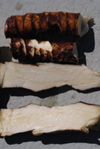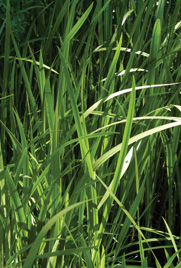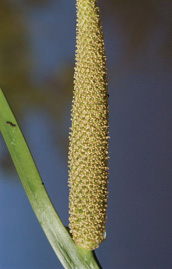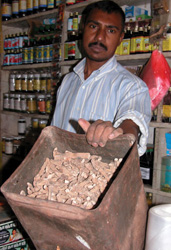

Fresh sections of the tough rhizome of calamus. Bruising or cutting the rhizome reveals an intense, sweet aroma.
THERE ARE FIVE REFERENCES IN the Bible to a fascinating plant translated as “sweet cane,” “calamus,” and “sweet myrtle” (Exodus 30:23; Song of Solomon 4:14; Isaiah 43:24; Jeremiah 6:20; and Ezekiel 27:19), the variety of names indicative of the confusion over which plant is intended. The Hebrew word is qaneh, a word used to describe other, unrelated plants with similar leaf shape.
The verses of the prophets Isaiah, Jeremiah, and Ezekiel clearly indicate the value of calamus and the fact that it was widely traded with nations in Asia: “You have not bought expensive reed for me or sated me with the fat of your sacrifices” (Isaiah 43:24a, NJB); “What do I care about incense from Sheba or sweet calamus from a distant land? Your burnt offerings are not acceptable; your sacrifices do not please me” (Jeremiah 6:20, NIV); and, “Danites and Greeks from Uzal bought your merchandise; they exchanged wrought iron, cassia and calamus for your wares” (Ezekiel 27:19, NIV).
Two plants have been suggested for calamus in Bible plant literature. The first is a widespread plant of the Old World, Acorus calamus. The second is lemon grass. Lemon grass is the common name applied to species of the genus Cymbopogon, most commonly C. citratus, which are grasses that produce a lemon flavor and scent. Many lemon flavorings in soft drinks are derived from this grass rather than from lemons. In central Sudan, villagers use native lemon grass to thatch huts because the grass’s aromatic content repels insects. But I do not think lemon grass is the calamus of the Bible.

Acorus calamus, Hertford County, North Carolina. Calamus is the only Bible plant to have become invasive in North America. Its erect, narrow leaves may be the source of the Hebrew name qaneh, which is also applied to other plants with similar leaf shape.

The flowers of calamus are tiny and crowded on a thick, fleshy axis.

Ayurvedic herb shop in Matale, Sri Lanka, with bin of Acorus calamus. Calamus was widely traded in the ancient world and is a valued commodity today.
Rather, calamus is almost certainly Acorus calamus. At one time considered a relative of the common houseplant philodendron, the genus is now known to be a distinct group of plants. It has an ancient history and was widely traded in ancient times (Miller 1969), evidence that it is the biblical calamus.
A plant of wet areas like margins of rivers and lakes, calamus is valued for the sweet fragrance of the rhizome from which various extracts are derived. The rhizome has been collected and candied, though the oil is recorded as being toxic (Leung and Foster 1996). In a review of its ethnobotany, Motley (1994) suggests that Acorus calamus is the calamus mentioned in Exodus: “Take the finest spices: 500 shekels of fresh myrrh, half as much (250 shekels) of fragrant cinnamon, 250 shekels of scented reed [qaneh]” (Exodus 30:22–23, NJB). Acorus calamus is not listed in a modern treatment of perfumery (Calkin and Jellinek 1992), but it is still used in medicine and cosmetics (Leung and Foster 1996).
Song of Solomon 4:14 indicates that “calamus” was grown as a garden plant. It is easy to grow and is a common component of home gardens in many parts of Asia because of its use in ayurvedic medicine.